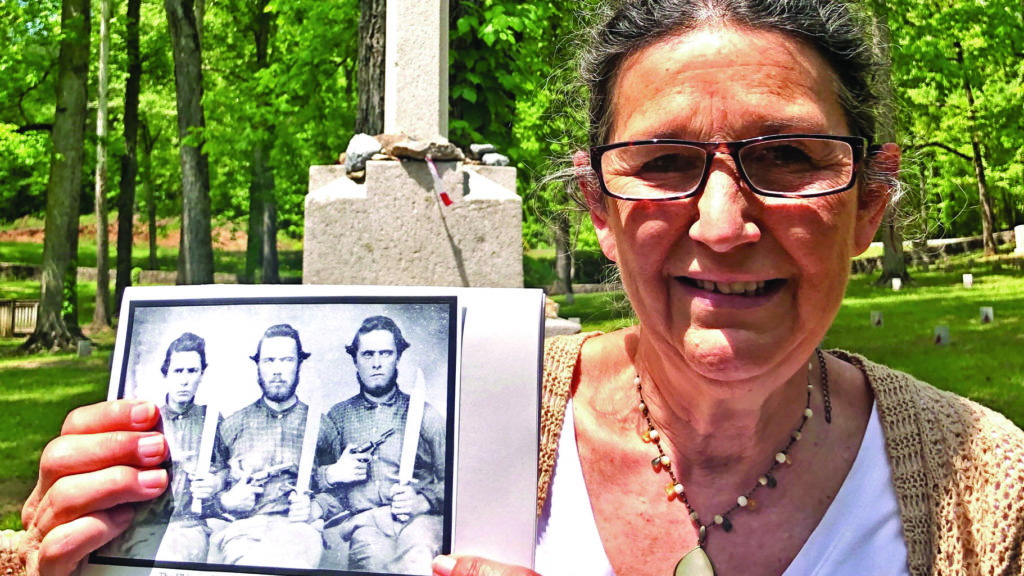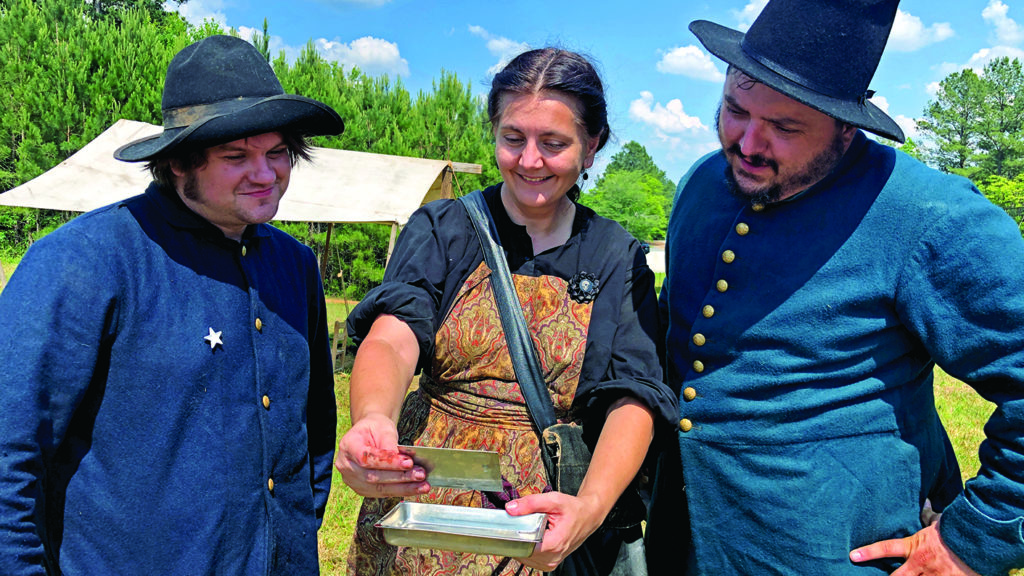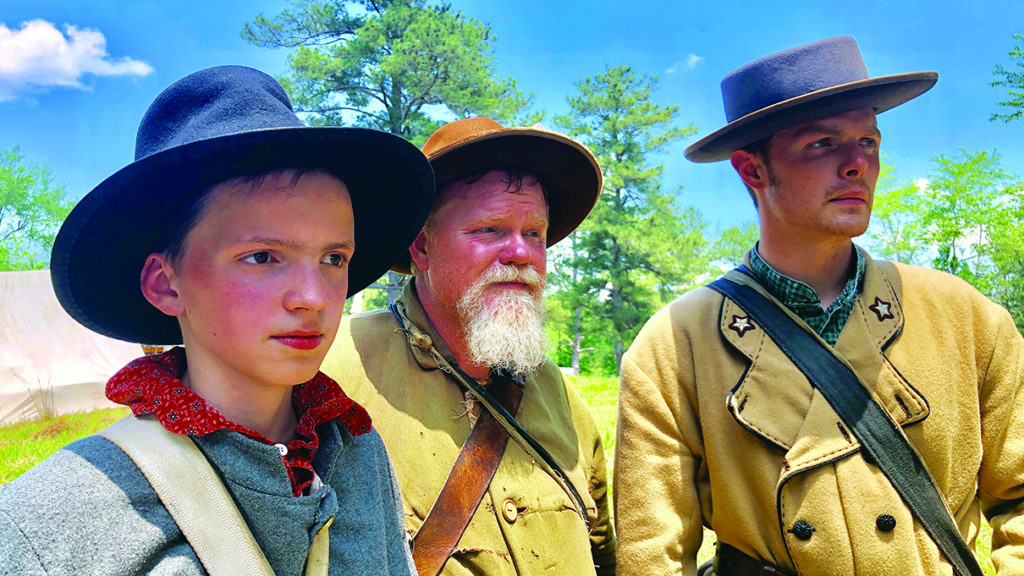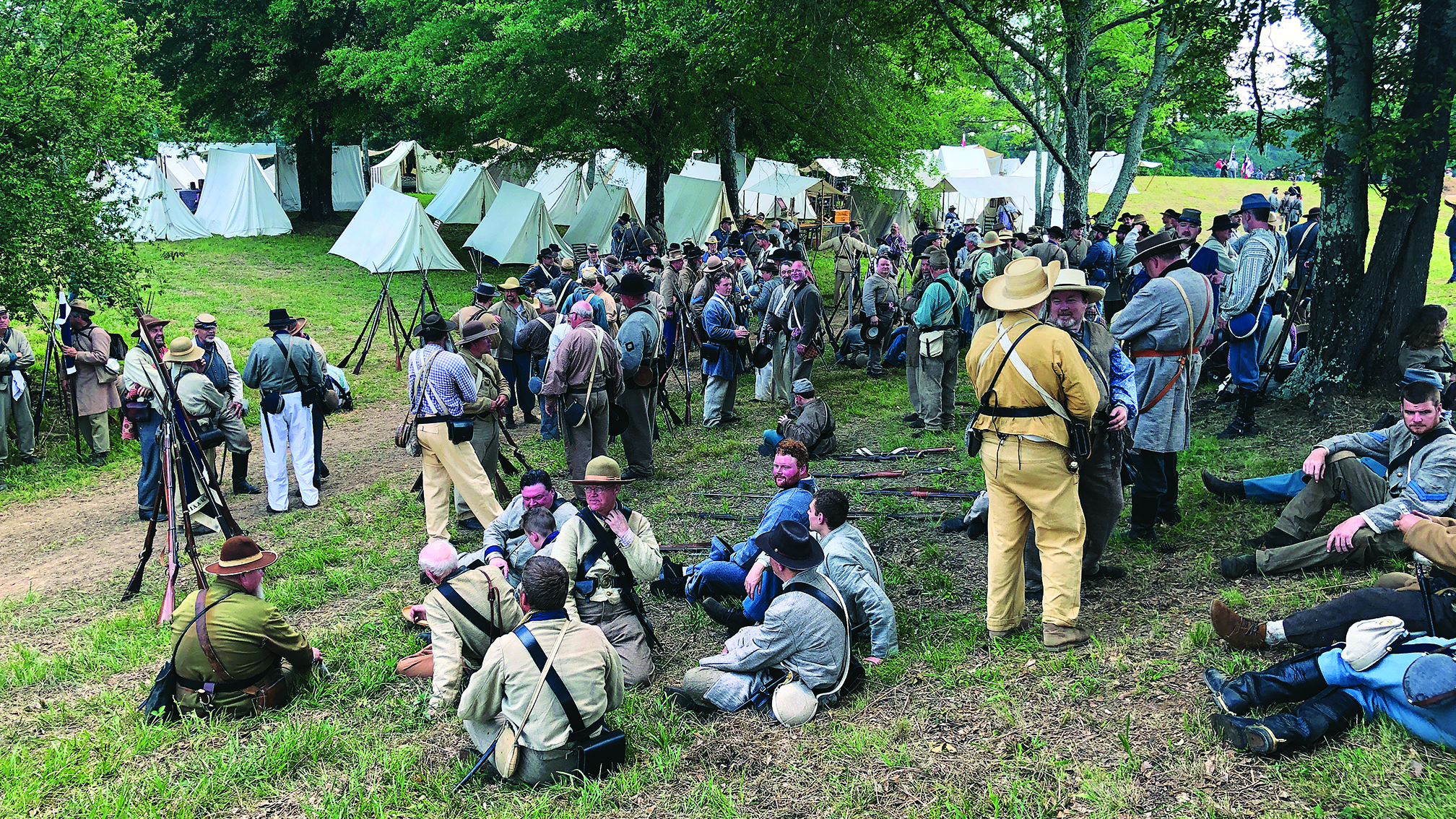Civil War buffs descend on small Georgia town for part-country fair, part-history lesson
From the porch of her late–20th century log house on the Resaca battlefield, Melea Medders Tennant admires tall pines and oaks, dogwoods, and rolling hills. She often hears a roar nearby of trains that follow the same line the Western & Atlantic Railroad did during the Civil War. “I feel like I am so attached to this place,” she says about the hallowed ground where Union and Confederate armies clashed on May 13-15, 1864. “It’s part of me.”
Tennant’s roots run deep in this rural area in northwestern Georgia: About the Great Depression, her grandfather Thurman Chitwood exchanged bales of cotton for acreage that comprised much of the battlefield. For decades, members of her extended family farmed the property, growing cotton, corn, and soybeans.

The Civil War touches Tennant’s family deeply, too. Her great-great-grandfather Daniel Chitwood served as a private in Company A of the 23rd Georgia, the “Bartow County Yankee Killers.” As a child growing up in nearby Whitfield County—“where the Yankee lines are”—Tennant recalls playing in the remains of Civil War trenches. She placed pine tree limbs and pine straw over ditches dug by Union soldiers, creating the “greatest huts in the world.” In an age before air-conditioning, the playground in the woods was a cool respite.
Every April, Tennant honors fallen Confederates from Resaca at the Confederate Memorial Day observance at a cemetery on the battlefield. During construction of her log house, on the site of a long-gone wartime home, Tennant spotted a chunk of a cannon ball revealed by a bulldozer. Every parcel of land near her family’s log home evokes a memory.
“Back when I walked these fields with my brother, we hunted for arrowheads, found Minié balls,” says the president of the local chapter of the United Daughters of the Confederacy. “It just means something to me. Every hill, the way the land curves…”
Her voice trails off.
Now roughly 55 acres of Resaca battlefield land remain with Melea and her family. In 2008, the nonprofit Trust for Public Land acquired several hundred acres once owned by Tennant’s family, preserving it for future generations. (In 2012, the American Battlefield Trust and two Georgia preservation groups acquired 51 acres of Resaca battlefield from the TPL.) An easement, thankfully, prevents developers from desecrating hallowed ground.
Each May, near the anniversary of the Atlanta Campaign battle, the Trust for Public Land allows a reenactment on the ground where Yankees and Rebels spilled blood. Tennant, a 67-year-old retired teacher, relishes the event.
It is, after all, right in her front yard.
Several hours before the start of the reenactment, Federal and Confederate troops deploy by distinctly non–19th century methods: SUVs transport Yankees and a tractor tows Rebels on a trailer bed lined with hay. Adult spectators pay $5 ($2 for kids 12 and under) for admittance. Near the entrance for the event, a black-and-white sign warns: “No Relic Hunting.”
Held annually since 1983, the reenactment is part-country fair, part-yard sale, part-Civil War history lesson. Near the battle site, spectators purchase boiled peanuts, fried nutter butter, and the usual assortment of fast food. Then some wash it all down with a bottle of Ole Doc Bell’s homemade birch beer.
In tents pitched near the Rebel camps, vendors sell faux Confederate currency, Confederate-themed bumper stickers (“Fightin’ Terrorists since 1861,” reads one) and Battle of Resaca anniversary tie-dyed T-shirts.
Under a tent stuffed with books and Civil War knickknacks for sale, Angela Goodson admires coffee mugs adorned with images of her ancestors, Confederate generals Albert Sidney Johnston and Joseph Johnston. At Resaca, Johnston’s Army of Tennessee slugged it out against three Union armies under Maj. Gen. William Tecumseh Sherman. A Georgia native, Goodson claims a line of Confederate ancestors besides the commanders. “A bunch of uncles and granddaddies,” she says.
At a Confederate reenactors’ camp on a knoll, 83-year-old Jere McConnell dispenses good humor and information to spectators in between bites of a hamburger. A sign near his tent reads: “Provost HQ. No Spittn’. No Drankn. No Cussn.” Another reenactor jokingly proclaims about McConnell: “He’s the oldest living veteran of the Civil War.”
With a full, white beard, 78-year-old Robert Miller bears a fine resemblance to a post–Civil War Robert E. Lee. The retired computer programmer from Oklahoma sits under a small tent, meager protection from a fierce early-afternoon sun. Piled on a plastic table in front of him are copies of his book, They All Wore a Star, detailing the 129th Illinois’ Civil War experience and its fight at Resaca, the regiment’s first battle.
The Illinois boys suffered nine killed and 38 wounded at Resaca. Among the dead was Miller’s great-great-grandfather, Private Joseph Peters of Company F, killed instantly on May 15, 1864, when a bullet smashed into his brain. His great-great-grandson eagerly tells his story, about a quarter-mile from Joseph’s death site.
A 20-something private, Peters served with his two brothers. Miller points to a section in the front of his book, a condolence letter from Lieutenant William Smith to his ancestor’s widow. “Joseph was like a brother to me,” the officer wrote. “Many of the days we have passed together both as school boys and out of school. But he is gone and I am left. Maybe [I am] soon to follow as we expect to meet the enemy at any moment.”
In 2013, Miller visited for the first time the site where Peters was killed. In the woods, he found embrasures for Confederate Captain Maximillian Van Den Corput’s “Cherokee Battery.”
The ground looked like the soldiers had left it in 1864. “It was an eerie and emotional feeling,” says Miller, “unlike the groomed parks with monuments, like Chickamauga.”

Wearing a long Civil War–era dress, tintypist Christine Eadie munches on a sandwich near her portable studio. Her hands are spotted with black, traces of silver nitrate used to create photography magic. Even if she doesn’t shoot another image, the Charleston, S.C., area resident’s day is a great success.
“It might be the best of the weekend,” Eadie says of a whole-plate tintype she shot earlier of seven Federal reenactors from a unit called the Armory Guards. “I might as well go home.” These Yankees, says Eadie, pointing to her “perfect” photographic creation on her cell phone, are campaigners, a little more hardcore than your normal reenactors. They take extra pains to make sure their uniforms are as authentic as possible. For the shoot, the Armory Guards wanted Eadie to mirror a wartime image of Federals in the field.
“There are just higher expectations from campaigners,” says Eadie, who has taken her portable studio to reenactments from Olustee, Fla., to Gettysburg. “There’s more pressure on me…they give me a challenge.”
Eadie gets special satisfaction when she delivers a work of art. “I’ve had people give me thumbs up and applaud,” she says, “and others hug me and cry when I shoot a photo of a baby. Then I cried. This is why I do it. I could make more money shooting weddings, but I’m creating heirlooms.”
The Armory Guards are pleased with Eadie’s work, which cost them only $80. “We wanted a bad-ass picture,” says reenactor Joe Knight, a 33-year-old attorney from the Atlanta area, “and this picture is just really bad-ass.”
Chomping on the stubby remains of an unlit cigar, reenactor Charles Garvin, who portrays a Confederate sergeant major, recalls the good old days of the hobby. “I knew of a reenactor who had a wooden canteen he put moonshine in,” the 76-year-old retiree says. “He put in some water to make it 100 proof.”
Garvin laughs as he recalls a long-ago reenactment at Resaca, when he kicked up a few Minié balls. “You’re not supposed to have a detector here, but I had my foot as a detector,” he says.

A reenactor since 1962, Garvin fondly remembers the 125th anniversary reenactment in 1988 at Gettysburg, where he estimates nearly 14,000 living historians participated. There are only a few hundred at Resaca, including some from Ohio, South Carolina, Alabama, and Mississippi. They also include three generations of one family—Georgia natives Todd Suits, his son Owen, and his grandson Corey.
Garvin wonders how much longer the hobby may last. Reenacting is expensive. “Back in the day,” he says, “we used to get JCPenney’s work pants and a shirt to reenact. Some of them even used original muskets.”
And the hobby skews older, too. Few young men and women are found in the camps at Resaca, leading several to wonder how long reenactments such as this may be held. But reenactors young and old talk of how meaningful it is to reenact on Resaca hallowed ground.
“It’s a rush to be on this field,” says Owen Suits. “It always sends a chill up your spine.”
“These reenactors” adds Melea Medders Tennant, “just love this land.”
It’s nearly 2 p.m., time for fightin’. The Confederate camp stirs. Antique tractors transport stragglers to the viewing area. Artillerymen prime cannons.
“Let’s hear the Rebel Yell, boys,” an officer shouts. The Battle of Resaca begins again.
John Banks is based in Nashville, Tenn.





